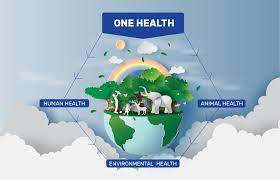One World- One Health: Prevent Zoonoses
Zoonoses are the diseases and infections, that are naturally transmitted between vertebrate animals and humans. The word zoonosis (plural zoonoses) has been derived from two Greek words (zoon means animals and noson means animals) and the term coined by Rudolph Virchow at the end of nineteenth century. It has been proven that approximately 75 percent of emerging diseases caused by different pathogens are zoonotic in nature. Out of which about 60 percent are transmitted to human via domestic or wild animal and 80 percent through bioterrorism across the world.
There are three classes of zoonosis:
1) endemic zoonosis-which are present in many places and affect many people and animals; 2) epidemic zoonosis-which are sporadic in temporal and have special distribution; and
3) emerging and re-emerging zoonosis- which newly appears in the population or have excised previously but increasing rapidly in incidence or geographical range.
It is estimated worldwide that about one billion cases of illness and millions of death per year occurs due to zoonotic diseases. Approximately 25 percent original forest cover has been lost due to periodic encounters of humans and domestic animals with wildlife. Human activities have severely destroyed or altered more than 75 percent of terrestrial environments and 66 percent of marine environments. Consequently, infectious disease transmission has been exacerbated, thus causing as much as 20 percent global animal production loss and severely affecting food security.
In last 20 years, the world has faced several zoonotic disease outbreaks, such as the viral diseases of Ebola virus, hanta virus disease, highly pathogenic avian influenza, West Nile disease virus, Rift Valley fever, severe acute respiratory syndrome, Marburg disease, rabies virus, Middle East respiratory syndrome, monkeypox disease and the COVID-19 pandemic as well as the bacterial diseases of anthrax, brucellosis, tuberculosis, salmonellosis, Escherichia coli (O157:H7) and Yersinia pestis infections. Some zoonoses may cause repeated outbreaks, whereas others may cause potential worldwide pandemics and have been declared public health emergencies of international concern by the World Health Organization.
These zoonotic infections are also a concern to global health security, because of its ability to spread internationally due to global connectivity and proliferation of trade, including trans-boundary movement of animals. The emerging zoonoses are also responsible for economic losses, due to loss of animal trade, travel and opportunity for job. The risk of emerging and re-emerging diseases spread and their burden has been increased due to extensive interactions among animals, human and ecosystem as well as due to explosive growth of livestock and human population, rapidly increasing urbanization, change in farming system and close interaction between wildlife and domestic animals, globalization in the trade of animal and animal products, antimicrobial resistance and climate change.
The high risk of emerging and re-emerging disease spill over and burden has been increased by the extensive interactions among animals, humans and ecosystems as a result of exponential growth of livestock and human populations; rapidly increasing urbanization and changing farming systems; close interactions between wildlife and domestic animals (followed by forest encroachment, habitat destruction and ecosystem changes); globalization in the trade of animal and animal products; antimicrobial resistance; and climate change. Land use changes due to improper use and overuse of natural resources, together with the effects of climate change (such as floods, drought, forest fires and the heat island effect) have led to severe degradation and/or destruction of entire ecosystems, thus resulting in a loss of natural protection against disease emergence. In contrast, wildlife habitat fragmentation because of infrastructure development, urbanization and unregulated exploitation (through extensive hunting, trade and consumption) has contributed to decreasing biodiversity; increasing disease vector and host interaction; and exacerbating disease spillover across wild animals, domestic animals and humans. Antimicrobial resistance due to the misuse of antibiotics and other medicines, particularly in animal rearing, hinder the treatment of diseases and resistant microorganisms. Environmental pollution has also facilitated the spread of disease via water, air and soil. In addition, foodborne pathogens such as bacteria, viruses and parasites have increased the worldwide burden of diseases. Currently, food safety is affected by several challenges (such as population growth and migration, changes in food production and distribution systems, globalization of the food trade, growth in meat consumption and frequent consumption of meat by humans), which can result in continual contamination and the occurrence of food-borne disease. Consumption of contaminated food causes foodborne illness in 600 million and death of 400,000 people each year. The sources of these foodborne illnesses are products of animal origin, fruits, vegetables and contaminated water.
Therefore, food safety should be assured through an integrated multi-disciplinary approach. This complex and interconnected health threat based on animal–human–environment interactions strongly requires inter-sectoral integration and/or collaboration not only to decrease the burden, but also to enable effective prevention and control of all zoonotic diseases in future. This goal can be achieved through the One Health approach and its coordination mechanisms. The One Health approach is an effective platform organizing all relevant stakeholders (in animal, human, environmental and other relevant sectors), which also can provide substantial benefits for health sectors and their development goals through convening relevant governmental agencies. However, the implementation mechanisms of the One Health approach to decrease and prevent zoonotic diseases remain poorly understood and have received little attention worldwide, particularly in low income countries. Thus stake of developed nations increases many fold to overcome this menace and one world policy is needed. Moreover, the dynamics, and the economic and epidemiological mechanisms of preventing and controlling the persistence and emergence of zoonoses are unclear.
To obtain compiled information for better understanding effective systems for controlling zoonotic diseases, reviewing and framing the One Health and one world approaches, policies and available global best practices is critical. Therefore, it can be concluded that recent scientific policies, initiatives, best practices, systems and challenges across the globe are of huge wants to zoonoses.
Dr Vibha Yadav
Assistant Professor
Deptt. Veterinary Microbiology
ANDUAT, Kumarganj Ayodhya


